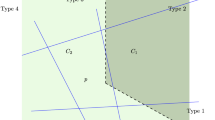Abstract
Given a set of n disjoint line segments in the plane, we show that it is always possible to form a tree with the end-points of the segments such that each line segment is an edge of the tree, the tree has no crossing edges, and the maximum vertex degree of the tree is 3. Furthermore, there exist configurations of line segments where any such tree requires at least degree 3. We provide an O(n log n) time algorithm for constructing such a tree, and show that this is optimal.
Preview
Unable to display preview. Download preview PDF.
Similar content being viewed by others
References
D. Avis and D. Rappaport. Computing monotone simple circuits in the plane. Computational Morphology. Elsevier Science, G.T. Toussaint (editor), North Holland, 1988.
J. A. Bondy and U. S. R. Murty. Graph Theory with Applications. Elsevier Science, New York, New York, 1976.
P. Bose and G. Toussaint. Growing a tree from its branches, Proc. of the First Pacific Conference on Computer Graphics and Applications, Vol 1, pp. 91–103, 1993, Also: McGill Technical Report no. SOCS 92.12, McGill University, 1992.
P. Bose, M. Houle, and G. Toussaint. Every set of line segments admits a binary tree. McGill Technical Report, McGill University, (to appear).
A. Mirzaian. Hamiltonian Triangulations and Circumscribing Polygons of Disjoint Line Segments. Computational Geometry: Theory and Applications, 2, 1, pp. 15–30, 1992.
C. Monma and S. Suri. Transitions in geometric minimum spanning trees. Proc. ACM Symp. on Comp. Geom., pp. 239–249, 1991.
F. Preparata and M. Shamos. Computational Geometry: An Introduction, Springer-Verlag, New York, New York, 1985.
D. Rappaport. Computing simple circuits from a set of line segments is NP-complete. Proc. 3rd ACM Symposium on Computational Geometry, Waterloo, Ontario, pp. 52–60, 1987.
D. Rappaport, H. Imai, and G.T. Toussaint. Computing simple circuits from a set of line segments. Discrete and Computational Geometry, 5, 3, pp. 289–304, 1990.
E. Rivera-Campo and J. Urrutia. Personal communication. August 1992.
X. Shen and H. Edelsbrunner. A tight lower bound on the size of visibility graphs, Information Processing Letters, 26, pp. 61–64, 1987.
M. Urabe and M. Watanabe. On a counterexample to a conjecture of Mirzaian. Computational Geometry: Theory and Applications, 2, 1, pp. 51–53, 1992.
Author information
Authors and Affiliations
Editor information
Rights and permissions
Copyright information
© 1994 Springer-Verlag Berlin Heidelberg
About this paper
Cite this paper
Bose, P., Houle, M.E., Toussaint, G. (1994). Every set of disjoint line segments admits a binary tree. In: Du, DZ., Zhang, XS. (eds) Algorithms and Computation. ISAAC 1994. Lecture Notes in Computer Science, vol 834. Springer, Berlin, Heidelberg. https://doi.org/10.1007/3-540-58325-4_162
Download citation
DOI: https://doi.org/10.1007/3-540-58325-4_162
Published:
Publisher Name: Springer, Berlin, Heidelberg
Print ISBN: 978-3-540-58325-7
Online ISBN: 978-3-540-48653-4
eBook Packages: Springer Book Archive




